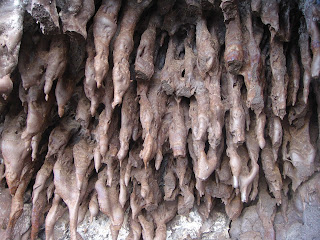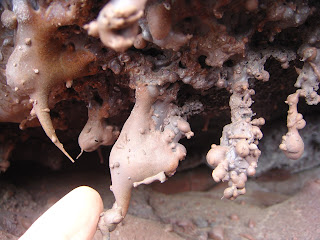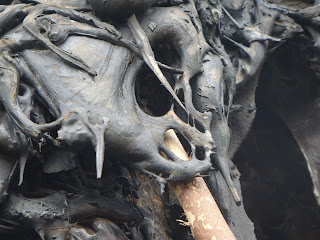The airport in Kailua Kona, Hawai'i is built on top of a lava flow barely 200 years old. Landing here is sometimes a jarring experience for tourists expecting waterfalls and rainforest because the landscape is instead a stark lava desert that looks a lot like dark brownie batter. Of course we have waterfalls and rainforests too, but they are elsewhere on the island.
I live on the side of Hualalai volcano, one of five volcanoes that make up the mass of the island of Hawai'i (note, Waikiki and Honolulu are on a different island, not here). Three of these are "active" volcanoes, meaning they are either erupting now (Kilauea, about 90 miles from my house), or are bound to erupt again in the future (Mauna Loa and Hualalai). One of the remaining two is likely extinct (Mauna Kea, which has many world-class telescopes on its summit) and the other is quite dead (Kohala).
In short, there is a lot of lava around.
Most people assume that volcanoes erupt at their summit, often explosively, and lava flows down the sides in waves that gradually build the cone higher and higher as the lava cools. But like many of our assumptions about lava, this one is very oversimplified. For instance, another major way that Hawaiian volcanoes grow is by swelling from the inside as magma forces its way into cracks and crevices on its way to the surface. Kind of like a pimple as it gets ready to "erupt" except that lava pimples are permanent and don't go away afterwards.
Another way is even more interesting, at least to a lava lover like me. If a volcano erupts for a long enough period of time, it develops lava tubes, or conduits, through which the lava can flow for miles before being deposited on the flanks of the volcano. The lava first forms channels, like stream beds or river beds, except that the force at work is
thermal erosion, not
water erosion -- the new lava melts its way into the older surface. As the lava ebbs and flows in these channels the cooling sides get higher and higher and eventually close over the top, making an insulated route for lava to travel great distances before breaking out and coating the landscape. The tubes can form a complex system in which they take different routes for a ways, then come together and diverge again, and each main tube can have many smaller side tubes. Also, newer flows can create tubes that enter older ones at a higher level making multi-tiered systems that resemble complex highway intersections.
When an eruption stops completely the lava in the tubes drains away, leaving empty conduits that can be as big as subway tunnels. The cooling lava contracts and sometimes crumbles, collapsing the tube at its weakest points. But long portions often remain intact. For instance, the southern part of our island hosts one of the longest intact tube systems in the world, with over 32 miles of interconnecting underground conduits. Shorter sections of tubes can be found in nearly all parts of the island.
To a near-geezer like me who wants to prove he is still young enough to do stupid and slightly dangerous things, these old tubes are irresistible. For the past several years my hiking buddy from Oregon (also a near-geezer) and I have been exploring old lava flows and investigating the tubes that we can find. Many of the tubes and openings are undocumented and unmapped and they aren't described in any guidebook. They are also very difficult to find because the openings become hidden by vegetation or are in remote areas. We've learned that some of the most unpromising-looking landscape can hold geological treasures, and we've become pretty good at reading the subtle clues in the terrain that
may lead us to a great tube adventure. It is terrifically rewarding to come across an opening and think that we used our wits (well, what's left of them) to locate it. Very ego-boosting for near-geezers.
And getting inside is nearly always an awe-inspiring experience. We're walking in the island's arteries, where 2000 degree molten rock once flowed and seeing the products of an unfathomably powerful geologic process from the inside! Wow!
As lava flows through channels and tubes it spatters, splashes, and splatters, producing a limitless variety of fascinating swirls, drips, and globs that freeze in place as the lava cools. [See my photos at the end of this blog for examples.] Some of these structures are extremely complex and delicate. For example, the air movement that accompanies the flowing lava can produce a long drip that is needle-sharp and cools horizontally. Gusts of air can also whip a long drip and stick the tip upward to form a loop or even a knot. Some other features are
- lavacicles -- vertical stalactites from the ceiling of tubes. These aren't formed by dripping water, though, but by the remelting of the ceiling as newer lava flows in the tube or by overhead intrusion of lava from a new surface flow over the old tube.
- stalagmites -- pillars of lava on the floor of a tube formed from lava dripping from the ceiling. The heat in this case may come from new lava flowing over the top of the tube.
- bathtub rings -- newer lava flowing through a tube often leaves a "high lava" mark when it drains away. Sometimes these are so thick they form benches along the tube walls.
I want to be clear that we are very respectful of the formations we find and try to be careful not to damage them. And we
never intentionally break off any of the features.
As rewarding as this activity is, there are also costs. Hiking across a lava flow is a bit like using one of those balance boards at the gym -- the surface is uneven, unstable, and very unfriendly to aging muscles. Moving through a tube sometimes requires a "duck-walk" strategy that aging knees really don't like at all. And lava is really, really, really sharp. Barely brushing against it can produce prodigious amounts of blood from delicate old skin. Did I mention that "lava love" might be considered a bit stupid?
 |
| Complex drip patterns on side of a channel. |
 |
| Look at how sharp and delicate this drip is! |
 |
| A unique double-tipped drip. |
 |
| Drip with tip stuck upwards. Hiking stick handle for scale. |
 |
| Lavacicles |
 |
| Figure this one out!! |
 |
| Complex knobby drips with spatter on them. |
 |
| More delicate complexity. Hiking stick for scale. |
 |
| Alien hieroglyphs on side of tube. |
 |
| Lava stalagmites deep inside a tube. |
 |
| Great example of lavacicles. |
 |
| Sharp lavacicles on ceiling -- don't bump your head! |








